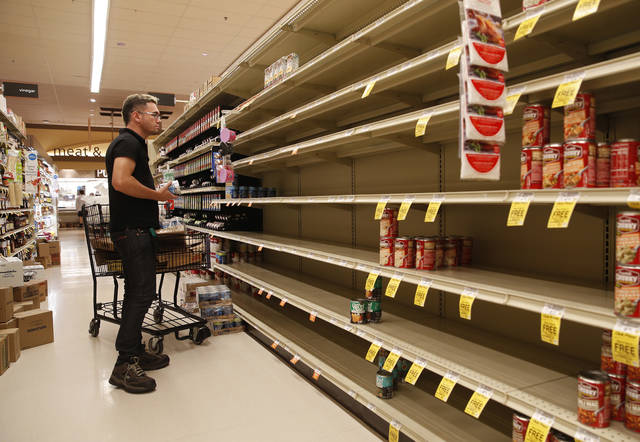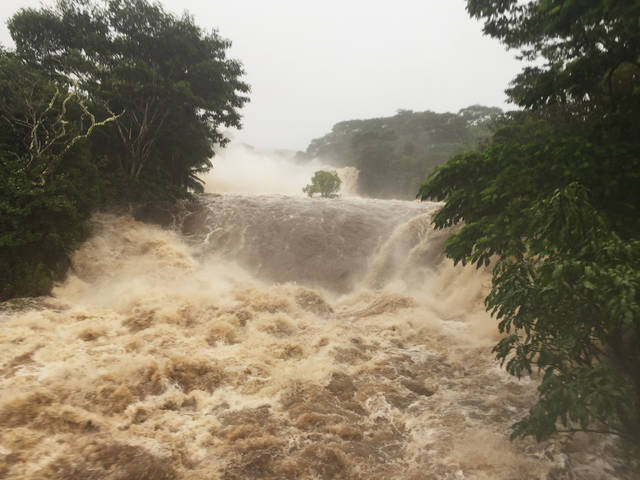HONOLULU — Hurricane Lane barreled toward Hawaii on Friday, dumping torrential rains that inundated the Big Island’s main city as people elsewhere stocked up on supplies and piled sandbags to shield oceanfront businesses against the increasingly violent surf.
The city of Hilo, population 43,000, was flooded with waist-high water. The National Guard and firefighters rescued six people and a dog from a flooded home. Five tourists from California were rescued from another home.
“There’s so much rain, the drainage is all saturated,” said Hawaii County Managing Director Wil Okabe. “We’re just letting nature take its course, getting water down to the ocean and responding to any rescues.”
As much as 35 inches (89 centimeters) of rain fell on the island in 48 hours. On the east side, crews responded to landslides.
Road closures “seem to be changing by the minute,” said Hawaii County Civil Defense spokeswoman Kelly Wooten. “They get cleaned up and there’s another landslide somewhere else.”
The Category 2 storm was expected to turn west on Saturday before reaching the islands and skirting Oahu — the state’s most populated island. Even without making a direct hit, the system threatened to bring a huge storm surge, high wind and heavy rain, forecasters said.
“There’s a lot of uncertainty in this forecast,” warned Federal Emergency Management Administrator Brock Long. “We hope all citizens are heeding the warning that local officials are putting out.”
On Oahu, gusts Friday morning rattled windows and roofs in Honolulu’s hillside neighborhood of Nuuanu overnight and scattered tree branches, palm fronds and at least one downed electrical line across roadways.
Almost 16,000 homes and businesses on the islands lost electrical power as the outer edges of the hurricane battered the islands, but service was restored to a portion of them, Hawaiian Electric spokesman Peter Rosegg said.
A brushfire on the island of Maui forced the relocation of a hurricane shelter in Lahaina as nearby residents were evacuated. Fire officials said the fire jumped a highway and was approaching a gas station. The flames spread to 300 acres (121 hectares), and a woman who was burned in the hands and legs was flown to Honolulu, Maui County spokesman Rod Antone said.
At 8 a.m., the center of the hurricane was about 170 miles (274 kilometers) south of Honolulu and spinning north at 2 mph (3.2 kph).
Police warned tourists to leave the world-famous Waikiki Beach ahead of the storm’s arrival in Honolulu. So far, about 1,500 people, mostly on Oahu, were in emergency shelters, said Brad Kieserman of the American Red Cross.
Emergency crews rescued five California tourists from a home they were renting in Hilo after a nearby gulch overflowed and flooded the house on the Big Island.
Suzanne Demerais said a tiny waterfall and small stream near the home turned into a torrent. Hawaii County firefighters evacuated the friends from the Los Angeles area by floating them out on their backs, Demerais said.
“It was quite an experience because we weren’t planning to have a hurricane during our vacation time,” Demerais said.
In Honolulu, employees of the Sheraton Waikiki resort filled sandbags to protect the oceanfront hotel from surging surf.
Stores along Waikiki’s glitzy Kalakaua Avenue stacked sandbags along the bottom of their glass windows to prepare for flash flooding.
The Marriott Resort Waikiki Beach in Honolulu designated a ballroom on the third floor as a shelter for guests and began removing lounge chairs from around the pool and bar area.
At the Hilton Hawaiian Village, guest Elisabeth Brinson said hotel staff left a notice that rooms will still have water and phone service, and a backup generator would power one elevator per building in the event of an electrical outage.
Brinson, a native of the United Kingdom now living in Denver, said many shops were closed, and those still open were frantic with people buying food, beer and water to take back to their rooms.
“We knew it was coming, so I tried to just cram as much as I could into the last few days in anticipation so we could cross things off of our list,” said Brinson, who is used to hurricanes after living in Florida.
United Airlines canceled its Friday flights to and from Maui. The airline added two more flights from Honolulu to San Francisco on Thursday to help transport people off the islands.
Hawaiian Airlines canceled all Friday flights by its commuter carrier, Ohana by Hawaiian. Some Hawaiian Airlines flights from the West Coast to Maui were delayed, but flights from the mainland to other destinations in Hawaii are operating as normal, said airline spokesman Alex Da Silva.
The biggest hotels were confident they could keep their guests safe as long as they stay inside, said Mufi Hannemann, CEO of Hawaii Tourism and Lodging Association.
“The only concern is those that venture outside of the properties, that would like to hike on a day like this or who would like to still go into the ocean and see what it’s like to take a swim or surf in these kind of waters,” Hannemann said.
The central Pacific gets fewer hurricanes than other regions, with about only four or five named storms a year. Hawaii rarely gets hit. The last major storm to hit was Iniki in 1992. Others have come close in recent years.
The Federal Emergency Management Agency moved several container ships packed with food, water, generators and other supplies into the region ahead of Hurricane Hector, which skirted past the islands more than a week ago, Long said. Warehouses were double-stocked with emergency supplies, and federal officials were working with grocers to ensure stores would have enough food.
———
Associated Press writers Brian Skoloff and Caleb Jones in Honolulu, Mark Thiessen and Dan Joling in Anchorage, Alaska, Colleen Long and Seth Borenstein in Washington and Annika Wolters in Phoenix contributed to this report.





